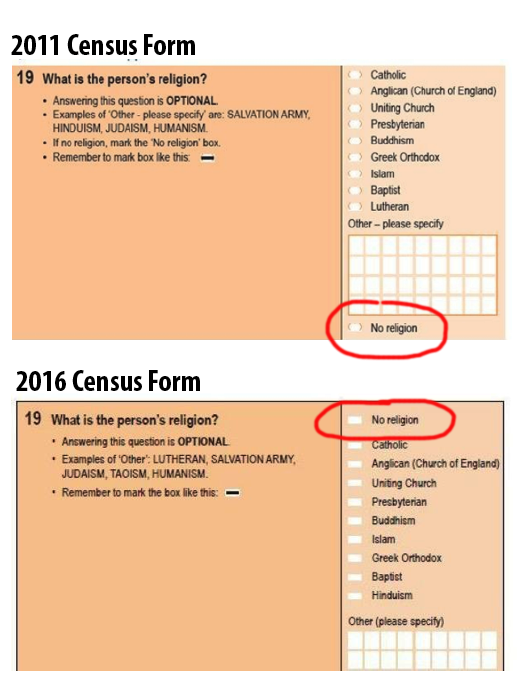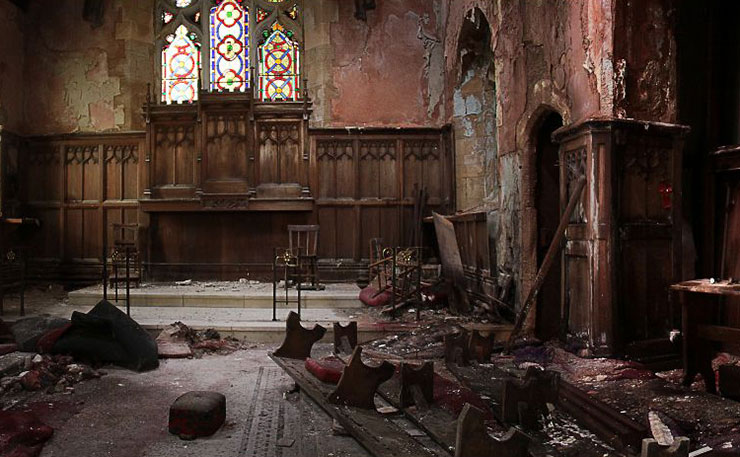If you’re a rationalist like Hugh Harris, then you’re probably looking forward to the results of the National Census next year.
The 2016 Census will feature a subtle, but important change on the topic of religion. In answer to “What is the person’s religion?” the option “No religion” will now appear first, eliminating a long-standing bias which has skewed the results in favour of Christianity.
This will see a rise in the recording of non-belief, which will may well provoke increased debate on the nature of our “secular” society.

In recent years the numbers of non-believers have steadily increased, becoming the second most populous category in the 2011 Census at 22.3 per cent (behind Catholicism at 25.3 per cent). This is despite the placement of the “No religion” option at the bottom of the form, below all the religious sects, underneath the table of “Other – please specify.”
Explaining the reasons behind the change, 2016 Census Program Manager Duncan Young, notes the convention to place the most popular choices first by the Australian Bureau of Statistics.
There’s no doubt previous results understate the number of non-believers. Bernard Salt expects a significant adjustment, not from a “sudden increase in godlessness,” but simply because of a more accurate survey result.
Other surveys bear this out. The 2011 Census had the total of Christian groups at 61.1 per cent. Yet a McCrindle study in 2012 shows that one third are more “spiritual” than “Christian.”
A 2012, WIN-Gallop survey of religiosity and atheism found 48 per cent of Australians were irreligious.
A Roy Morgan poll in 2013 found 37.6 per cent had no religion.
“No religion” has increased dramatically in recent years from 15.1 per cent in 2001 to 22.3 per cent in 2011. It is now the highest denomination among young people, with the 18-24 age group recording 29 per cent. It seems likely the trajectory towards “No religion” will continue with an added boost in the 2016 results.
“No religion” will likely overtake Catholicism to become the largest group in 2016. In addition, it’s likely that the total number of Christians will decline to about 50 per cent, or below. When the same thing happened in New Zealand “No belief” rocketed to 42 per cent.
It will no longer be reasonable to say that Australia is a Christian country. The disparity between its godless populace and its religion favouring policies will seem even more glaring.
Contrast this with the ways church and state currently conspire:
- The National School Chaplaincy Program is costing us $245 million a year. Despite the High Court twice ruling its funding invalid, chaplains are placed into public schools. According to the Scripture Union Queensland website they provide student welfare based on the “unconditional love demonstrated and taught by Jesus, as recorded in the Bible”.
- The increasingly evangelical Special Religious Instruction in schools are costing $800 million per annum.
- Tax exemptions and funding for religious activities are valued at $31 billion a year – or about $2,000 for each taxpayer (although of course the tax bill is not equally shared).
- There have been huge increases in funding for Independent and Religious Secondary Schools in 2008-9 and 2012-13.
There’s no way that a majority of Australians support these policies. Consider, only 8 per cent of Australians still attend church regularly. And, according to a 2008 Gallup poll, nearly 70 per cent of Australians regard religion as “having no importance.”
In 2009, Nielsen recorded 84 per cent agreed that ‘religion and politics should be separate’.
Nearly 40 per cent of Australian children attend private schools, scarcely any of which are non-religious. What do the 40 per cent of non-religious parents think about sending their child to a religious school?
Since most independent schools are Christian, many parents have their unbelievers baptised in either Anglican or Catholic churches in order to obtain admittance.
The proportion of Australian kids studying at religious schools ranks amongst the highest in the OECD.
Conservative media veteran, Gerard Henderson, notes dryly that “sneering secularists” mostly went to Christian schools.
How did these ingrates fail to hear the good news? Why are religious schools churning out secularists? That the revival of policies promoting Christianity has coincided with declining youth religiosity, indicates the trend away from faith is deep-seated and likely long term.
But secularism is not about making snarky remarks. It’s not actually the enemy of faith. Any view presupposing a zero sum game where either religion or secularism triumph, misunderstands what “secular” means.
“Rendering unto Caesar” simply entails removing policies aimed at promoting one particular set of beliefs. Thus, only those who wish to favour particular beliefs should see secularism as a threat.
Religious institutions are firmly entrenched in our society and they will retain their influence long after non-belief becomes the most common demographic. Given this, faith-based enterprises must distinguish the general public from their flock.
They should abide by community standards, not seek to direct them.
The results of the 2016 Census will provide a useful opportunity to reassess the role of religion in public life in Australia. And this is nothing to sneer about, or be afraid of.
Donate To New Matilda
New Matilda is a small, independent media outlet. We survive through reader contributions, and never losing a lawsuit. If you got something from this article, giving something back helps us to continue speaking truth to power. Every little bit counts.




